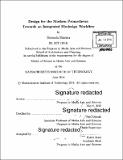| dc.contributor.advisor | Neri Oxman. | en_US |
| dc.contributor.author | Sharma, Sunanda,Ph. D.Massachusetts Institute of Technology. | en_US |
| dc.contributor.other | Program in Media Arts and Sciences (Massachusetts Institute of Technology) | en_US |
| dc.date.accessioned | 2016-12-22T16:26:50Z | |
| dc.date.available | 2016-12-22T16:26:50Z | |
| dc.date.copyright | 2016 | en_US |
| dc.date.issued | 2016 | en_US |
| dc.identifier.uri | http://hdl.handle.net/1721.1/106048 | |
| dc.description | Thesis: S.M., Massachusetts Institute of Technology, School of Architecture and Planning, Program in Media Arts and Sciences, 2016. | en_US |
| dc.description | Cataloged from PDF version of thesis. | en_US |
| dc.description | Includes bibliographical references (pages 131-136). | en_US |
| dc.description.abstract | Biodesign is a growing field that harnesses the re-engineering capabilities of synthetic biology and the principles of design to create functional products on a variety of scales. It is now possible to precisely modify and program living organisms to create products useful for medicine, fabrication, and more. These capabilities are today inspiring designers to consider, and design for opportunities associated with, the incorporation of biological and otherwise living matter into the built environment. Standard Computer Aided Design (CAD) software used in design and engineering often does not have resolution required for living systems, whereas many known bioCAD software do not allow for larger scales. In addition, simulations and animations are usually limited to a short timescale, and do not allow for predictive models over days or weeks. For creating environments in which living materials or systems, from bacterial biofilms to functional swarms, can intertwine with synthetically fabricated constructs, rapid prototyping software must be developed that can allow for both design and simulation in different conditions over time. This thesis is an attempt at creating a design methodology and finding a software platform for inclusion of living material systems in manufacturing of products on multiple scales. Existing biological CAD software is surveyed and applied to two case study projects engaging multiple scales (i.e. human scale, and architectural scale) for which the digital fabrication of living materials provides additional functionality and augments the biological or ecological environment. In the process, novel work is presented in the areas of apiary management and 3D printing with biology. Additionally, several computational approaches, including rule based and agent-based techniques, are applied to both projects and evaluated for accuracy and usability. This research took place in Mediated Matters newly constructed BL2 Wet Lab, and serves as a demonstration of research that lies at the intersection of additive manufacturing and synthetic biology. | en_US |
| dc.description.statementofresponsibility | by Sunanda Sharma. | en_US |
| dc.format.extent | 136 pages in various pagings (some unnumbered) | en_US |
| dc.language.iso | eng | en_US |
| dc.publisher | Massachusetts Institute of Technology | en_US |
| dc.rights | M.I.T. theses are protected by copyright. They may be viewed from this source for any purpose, but reproduction or distribution in any format is prohibited without written permission. See provided URL for inquiries about permission. | en_US |
| dc.rights.uri | http://dspace.mit.edu/handle/1721.1/7582 | en_US |
| dc.subject | Program in Media Arts and Sciences () | en_US |
| dc.title | Design for the modern Prometheus : towards an integrated biodesign workflow | en_US |
| dc.type | Thesis | en_US |
| dc.description.degree | S.M. | en_US |
| dc.contributor.department | Program in Media Arts and Sciences (Massachusetts Institute of Technology) | en_US |
| dc.identifier.oclc | 964698448 | en_US |
